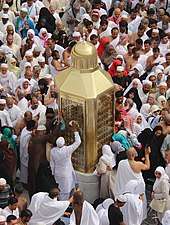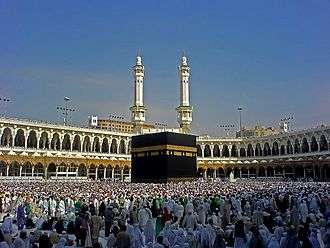Maqam Ibrahim
The Maqām Ibrāhīm (Arabic: مَـقَـام إِبْـرَاهِـيْـم, lit. 'Station of Abraham')[1][2] is a stone associated with Ibrahim, Ismail and their rebuilding of the Kaaba in what is now the Great Mosque of Mecca in Saudi Arabia. According to Islamic tradition, the imprint on the stone came from Ibrahim's feet.[3][4] According to one tradition it appeared when Ibrahim stood on the stone while building the Kaaba; when the walls became too high, Ibrahim stood on the maqām, which miraculously rose up to let him continue building and also miraculously went down in order to allow Ismail to hand him stones. Other traditions held that the footprint appeared when the wife of Ismail washed Ibrahim's head, or alternatively when Ibrahim stood atop it in order to summon the people to perform the pilgrimage to Mecca.[5]

See also
- Arabian peninsula
- Holiest sites in Islam
References
- Quran 2:125–197
- Quran 3:97 (Translated by Yusuf Ali)
- Peters, F.E. (1994). "Another Stone: The Maqam Ibrahim". The Hajj. Princeton, New Jersey: Princeton University Press. pp. 16–17.
- "Maqam-e-Ibrahim shines ... like visitors' faith". 25 September 2016.
- Kister, M.J. (1991). "Maḳām Ibrāhīm". In Bosworth (ed.). The Encyclopaedia of Islam. VI (Mahk-Mid) (2nd ed.). Brill. p. 105.
Further reading
- Kister, M.J. (1971). "Maqām Ibrāhīm: A Stone with an Inscription". Le Muséon. 84: 477–491.
People and things in the Quran | |||||||||||||||||||||||||||||||||||||||||||||||||||||||||||||||||||||||||||
|---|---|---|---|---|---|---|---|---|---|---|---|---|---|---|---|---|---|---|---|---|---|---|---|---|---|---|---|---|---|---|---|---|---|---|---|---|---|---|---|---|---|---|---|---|---|---|---|---|---|---|---|---|---|---|---|---|---|---|---|---|---|---|---|---|---|---|---|---|---|---|---|---|---|---|---|
| |||||||||||||||||||||||||||||||||||||||||||||||||||||||||||||||||||||||||||
| Celestial bodies | Maṣābīḥ (literally 'lamps'):
| ||||||||||||||||||||||||||||||||||||||||||||||||||||||||||||||||||||||||||
| Liquids |
| ||||||||||||||||||||||||||||||||||||||||||||||||||||||||||||||||||||||||||
| Events, incidents, occasions or times |
| ||||||||||||||||||||||||||||||||||||||||||||||||||||||||||||||||||||||||||
Note: The names are sorted alphabetically. Standard form: Islamic name / Biblical name (title or relationship) | |||||||||||||||||||||||||||||||||||||||||||||||||||||||||||||||||||||||||||
| History |
| |
|---|---|---|
| Landmarks and places |
| |
| Education | ||
| Sports |
| |
| Transport |
| |
| Pilgrimage | ||
